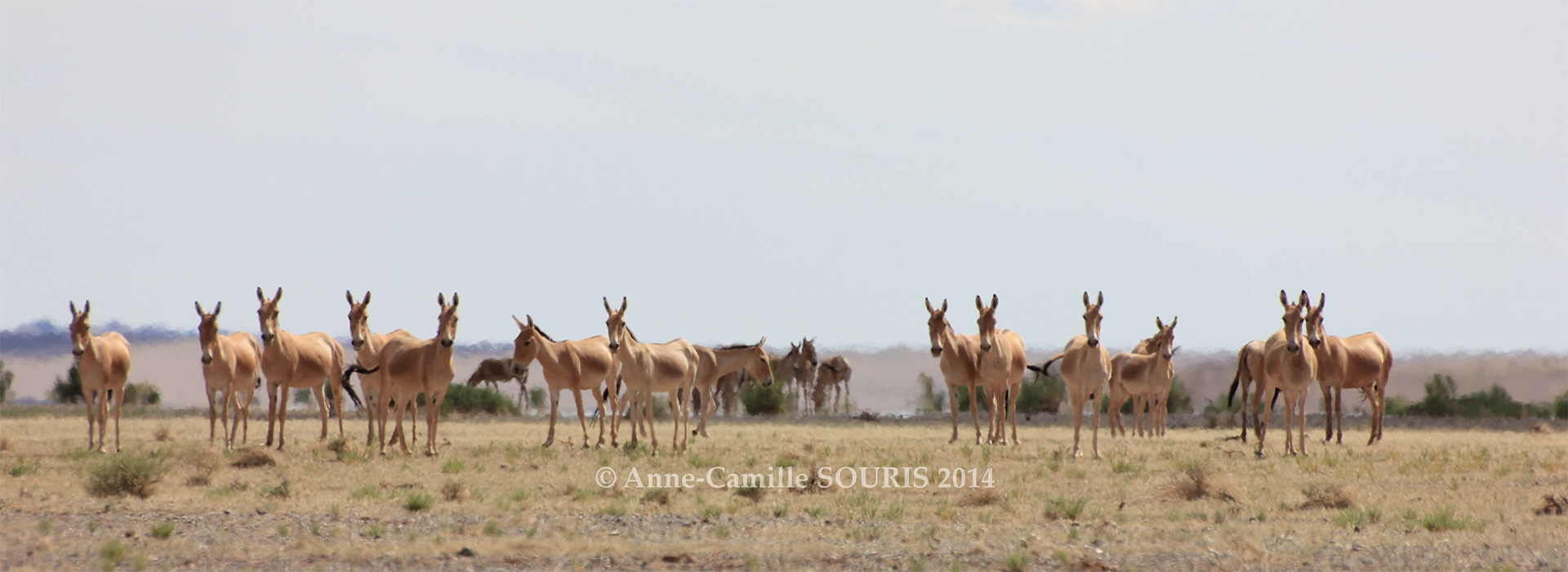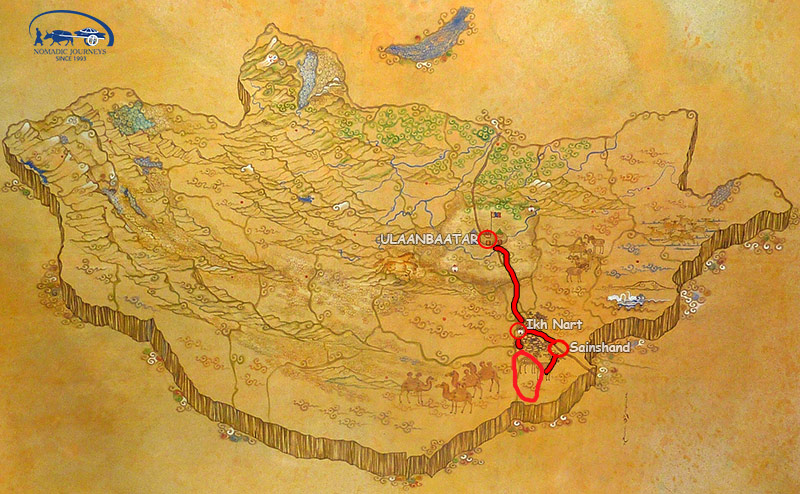
Wildlife Trails of the remote East Gobi
Introduction
From many tours to Mongolia that you can choose from, this one will lead you through Eastern Gobi Desert, unexplored Mongolian Nature and its true wildlife. Ride a camel through the Eastern Gobi Desrt, visit the Khamar Monastery and the Golden Mountain.
East Gobi Desert (Dornogobi) is one of the uncommon corners of the Mongolian Gobi Desert. It has the largest amount of endemic wildlife species. On this dramatic tour, you are privileged to follow Anne-Camille Souris, of the Goviin Khulan Association, who does on-going ground breaking research of Khulan, the Asiatic Wild Ass (Equus hemionus hemionus). It is a wild equid which has the densest distribution in the world here. Other subspecies of Asiatic Wild Asses remain in isolated pockets of Inner Asia such as the Indian Khur in the Little Rann of Kutch in Gujarat, India as well as the Onager of Iran and Turkmenistan. You will gain a privileged insight into the true wild Gobi, meet its hardy nomads and Buddhist monks who are partners in conservation.
You will be exposed to the conservation challenges in a remote corner of the world. The expedition will photograph and collect wildlife datas when in the remote areas.
| Trip Details |
|---|
| Wildlife Trails of the remote East Gobi (Goviin Hulan) |
| 15 Days / 14 Nights |
Trip Details
Day 1: To Ulaanbaatar
Arrival at Ulaanbaatar, capital city of Mongolia. Your local guide and driver will meet you the airport or railway station. In the evening we enjoy a dinner together.
Day 2: To the gateway to the Gobi Desert
You will visit Gandan monastery and see if we can assist to a religious ceremony. Gandan means in Tibetan “Great place of complete joy”. Gandan monastery escaped from the mass destruction of temples and monasteries, which occurred during the purges in 1937-1938. It reopened in 1944, and was allowed to continue as the only functioning Buddhist monastery, under a skeleton staff, as a token homage to traditional Mongolian culture and religion. To- day, Gandan is the largest monastery of the country. Hundreds of lamas live here.
On the July trip we will see Naadam horse race and view Mongol archery instead. In the late afternoon, your scientific host, Anne-Camille Souris, will explain about the activi- ties which will be conducted during the expedition and will provide you with basic training to collect data and record wildlife information. In the evening travel by overnight train to East Gobi. During the journey you will have the opportunity to socialize with members of the expedition team and rest.
Day 3: Khamar monastery to White Canyon
We Arrival at Sainshand (04h49) in early morning. We will directly travel to Khamar monastery. Visit the site guided by a Buddhist monk. Khamar monastery is known to be the famous en- ergy center, which is known as “Shambalal”. We will start out with a breakfast and 06h00 fol- lowed by an early visit to this amazing monastic site. On the return to Sainshand we will visit the museum dedicated to Danzanravjaa.
Danzanravjaa (1803-1856), was a famous Mongolian person, writer, poet, composer, painter and doctor. He was recognized as the 5th Noyon Hutagt, the Lama of the Gobi. At the Khamar monastery, he established a public library, a museum, a primary school, in addition to a professional public theater company called “Saran Hökhöö”. After lunch in a restaurant, we will travel to a watermelon plantation located in the area of Tsagaan Tsav, the White Canyon. You will visit this plantation and its greenhouse, guided by “Tugii”, the manager. He also cultivates other fruits and vegetables and grows saxauls (an endangered Gobi shrub). Tugii is since 2012 a volunteer ranger for the Association Goviin Khulan.
Day 4: To the Native Mountain
The “Native Mountain”, its Buddhist monastery and its protected area which contains some amazing pieces of petrified wood are about 3 hours drive away. You will discover – only a few
kilometers from the “Native Mountain” a site which is protected since 1996 where wood turned into stone (petrified) over the years. Unfortunately, this site is today threatened because of illegal robbery. Then, you will visit the nice Buddhist monastery which is located at the edges of the sacred mountain. The monastery was completely destroyed during the Soviet purges in the 1930s, but was partially rebuilt over the past twenty years. 4 monks now live here. They are all involved in the Goviin Khulan conservation program. During your stay, you may discuss with them about their actions and motivations toward protection of the Gobi ecosystem. You may also hike to observe wildlife and enjoy the beautiful landscapes and serenity. In early morning, it will be also possible to attend the prayers of these monks.
Day 5: To the Queen’s Spring
Drive for half a day south, to the south in direction of the border with China. You will experience different Gobi landscapes as we head south. We will stop at a small village on our way for lunch. Depending on their availability, it may be possible to meet with rangers working in the protected area here. We will then, travel to the south in direction to a natural spring named “the Queen’s spring”, Hatanbulag. We will pitch our tented camp nearby and observe wildlife and birds in the surroundings.
Day 6: To the Golden Mountains
In the morning, we will travel northerly for half a day to the Golden Mountains. We will again stop at the village where we stopped the day before, and continue north, but now in the direction of a Nature Reserve, famous for its dinosaurs fossils that have been found here in the past. It is a beautiful area, where it is best possibility to observe Khulan, Goitered Gazelles (black-tailed / Gazella subguttorosa) and Argali sheep (Ovis ammon). We will do some game drives here. Reliant on their availability, we will meet with a local family which are involved in the Goviin Khulan’s project. We will camp near their camp.
Day 7: To the Native Mountain
In the morning, we will travel back to the Native Mountain which are found not that far dis- tant from the Golden Mountains. We will do some game drives, to undertake additional data collection. We will thereafter return to the monastery by the late afternoon. Spend the night at the monastery.
Day 8: To the Zag Nature Reserve
In the early morning, you may join the prayers and chanting of Buddhist monks who live in this monastery. A unique experience in a beautiful and peaceful environment. After breakfast we will travel to the north in the direction to the Zag Nature Reserve which is located at the intersection between the three provinces, Dundgobi, South Gobi and Dornogobi provinces. It is a protected area since 1996. This reserve is characterized by its forest of saxauls (zag) and its specific wildlife, such as the Blacktailed gazelle and the Khulan that sometimes migrate to the north thus may be observed here.
Day 9: To Ikh Nartiin Chuluu Nature Reserve
We will now continue north – a full day drive – to the Ikh Nartiin Chuluu Nature Reserve. Ikh Nart is a reserve where the local community has created a partnership with the Denver Zoo Foundation, the Mongolian Academy of Sciences and Nomadic Journeys to conduct research and actions applied to conservation of the ecosystem of Ikh Nart region.
This reserve is char- acterized by rock formations and unique wildlife including Argali Sheep, Siberian Ibex (Capra sibirica), sometimes Mongolian Gazelles. As well as the largest vulture in Eurasia, the Cinere- ous Vulture (Aegypius monachus).
Day 10: Camel Trek
For three days we will explore the Ikh Nart area on foot having our luggage loaded on to a camel carts caravan. We will head out through the reserve and its labyrinth of rock forma- tions and try view different kinds of wildlife. There is Argali Sheep, which are most common to be seen, but also Siberian Ibex and bird life. Three parallel mammal research projects are on-going by Mongolian and foreign scientist’s. It is on Argali Sheep and Siberian Ibex, as well as on small carnivores primarily geared towards as Corsac Fox (Vulpes corsac), Red Fox (Vulpes vulpes), Badger (Meles meles) and Pallas’s Cat (Otocobolus manul) but also collecting any possible data on Lynx (Lynx lynx) and Wolves (Canis lupus) as well as its prey species such as gerbils, jerboas. And hedgehogs. For aviafauna there is ongoing research of Cinereous Vul- ture and Lesser Kestrels (Falco naumanni). Botanist’s are also regular visitors. Herders come and go at the Ikh Nart area. They are essentially reliant on pastures and any precipitation, why they are migrating a lot. Being Gobi herders, they migrate a lot. Very interesting, hospita- ble and hardy people. We will stay at a tiny Luxury Wilderness Camp of gers.
Day 11: Elst Area
Today We will remain in the camp here for another night. We will explore this wild area of rock formations, sands, grasses as high as 2 meters almost and a small ephemeral (seasonal) lake, which sometimes has desert tadpole shrimps! A relative to other tadpole shrimps in the de- serts of the Middle East and southwestern United States.
Day 12: Camel Trek
Today we again load the camel caravan with our luggage and walk in a loop through the reserve via the Red Rock Valley. Red Rock Valley holds one of the three permanent water springs why wildlife come here quite a lot. The distance is – as the crow flies – 13km to Red Rock Ger Camp.
Day 13: To Ulaanbaatar
Drive 5hrs to Ulaanbaatar, mostly on the tarmac road.
Day 14: Ulaanbaatar
In the morning, meet with your host, AnneCamille, about observations and results collected during this expedition. You will then visit the Winter Palace created by the last Bogd Khan (1869–1924). He was enthroned as Khagan of Mongolia on 29 December 1911. After lunch, you may use the time to buy some souvenirs. At 17h40 we will walk the short way across thes street to a nice performance of traditional Mongolian music, dance and songs. Farewell dinner.
Day 15: Departure
Airport transfer. Services ends after breakfast.
Itinerary Map

DATES ex. Ulaanbaatar: 2020
- Daily mid May to end of September.
PRICE 2020 ex Ulaanbaatar:
2 – 12 members: USD 3950 per person
Single ger supplement (14n): USD 1080
Practicalities:
Transport:
This is expedition style travel is supported by a light weight Russian 4wd furgon, to best negotiate the desert terrain.
Accommodation:
During this trip we will stay in spacious tentipis, with foldable bed-cots. Bring your own sleeping bag. We take along a Mongolian tent to serve as our mobile restaurant, as well as showers and compost toilets housed in traditional Mongolian marquee style tents. For two nights we stay at Ikhnart Rocks ger camp.
Staff:
An English speaking Mongolian guide will accompany the group at all times. There will also as your science host Anne-Camille Souris. To travel with a scientist in her habitat will provide for a complete understanding of Gobi ecology and its dynamics with current local nomadic livelihoods.
Meals:
Our cook will prepare the meals. We pride ourselves in having excellent cooks adept at both western and Mongolian cooking on our trips. There is no problem accommodating vegetarians on our trips.
Includes:
Cook and local guide. Leadership in French/English/Mongol. All meals outside Ulaanbaatar. All overnights and camping equipments. All local transport and entrance fees.
Excludes:
Beverages. Air or train tickets in and out Mongolia.
What our guests say
We appreciate your feedback about our tours and services.
You might also enjoy these trips





